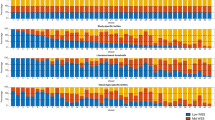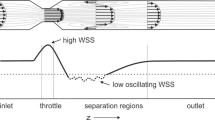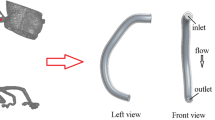Abstract
Shear stress in arteries, which is a measure of the force exerted by blood flow on the arterial wall, is associated with the location of lipid plaques that cause heart disease. In this study, a mathematical model of shear stress was combined with cross-sectional x-ray images of an artery taken using Computed Tomography (CT) scanning, allowing the authors to explore patterns of shearing stress and shed light on the role of arterial architecture in heart disease.
Similar content being viewed by others
Commentary
Rainbow colour scales, which usually run from dark blue (low values) to red (high values), are commonly used in several different types of biological images: functional magnetic resonance imaging (fMRI) scans showing activity in the brain, gene expression data in microarrays, or in this case, the levels of shear stress in arteries, expressed as unit of force/unit of area (in this case, dyne/cm2). One problem with the rainbow scale is that it can make relatively small differences seem large: the red sections of Fig. 1 appear very different from the yellow. However, the colour scale shows that the difference between yellow and red is actually much smaller than it appears visually, in the context of the whole colour scale range.
The opposite can also be true. In Fig. 1, green spans just under half of the whole colour scale, and differences between values at the lower and higher ends of the middle range are somewhat masked. These differences could be better represented with a diverging scale, running between two colours only. As long as these colours are not red and green, a diverging scale would also be more easy to interpret for red-green colour blind individuals. Michelle Borkin and co-workers at Harvard University recently found that a diverging scale increased accuracy of interpretation relative to the rainbow scale in the case of arterial shearing images [1], challenging the legitimacy of using rainbow scales in this field.
Reference
Borkin MA, Gajos KZ, Peters A, Mitsouras D, Melchionna S, Rybicki FJ, et al. Evaluation of artery visualizations for heart disease diagnosis. IEEE Trans Vis Comput Graph. 2011;17:2479–88.
Author information
Authors and Affiliations
Corresponding author
Rights and permissions
Open Access This article is distributed under the terms of the Creative Commons Attribution 4.0 International License (http://creativecommons.org/licenses/by/4.0), which permits unrestricted use, distribution, and reproduction in any medium, provided you give appropriate credit to the original author(s) and the source, provide a link to the Creative Commons license, and indicate if changes were made. The Creative Commons Public Domain Dedication waiver (http://creativecommons.org/publicdomain/zero/1.0/) applies to the data made available in this article, unless otherwise stated.
About this article
Cite this article
Saxon, E. Over the rainbow. BMC Biol 13, 62 (2015). https://doi.org/10.1186/s12915-015-0171-z
Published:
DOI: https://doi.org/10.1186/s12915-015-0171-z





